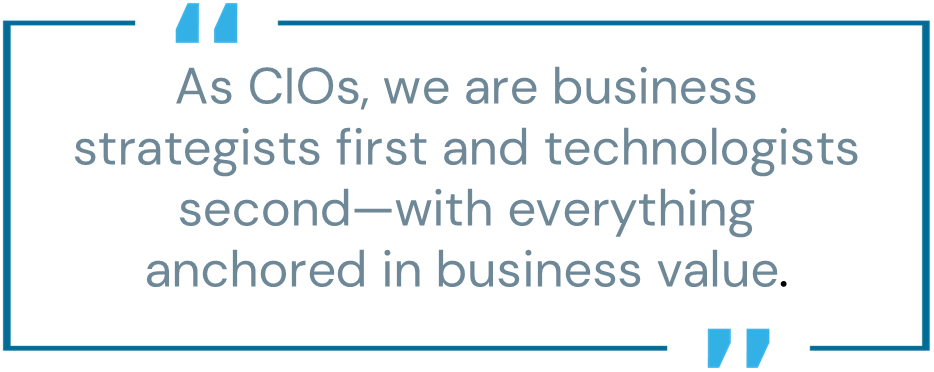
When the title of chief information officer (CIO) first emerged in the early 1980s, it was very different from what it is today. Technology evolution, emerging threats and new realities have shifted the role from simply “keeping the lights on” to strategically “enabling the business” in every way.
Yesterday’s CIO
The earliest CIOs were resident company tech experts, managing centralized computing infrastructure and just keeping the lights on. By the 1990s, businesses started moving online, technology reliance grew and this narrow “IT manager” focus began to expand. CIOs worked to decentralize technology and standardize business processes while enhancing their managerial skills.
CIOs shouldered even more responsibility as the web era matured during the 2000s. They deployed large enterprise resource planning (ERP) systems and integrated various communication-enhancing solutions across their organizations, building strategic relationships and business savvy in the process. Increasingly, they worked directly with the CEO on key business initiatives.
The shift to the cloud further elevated the CIO’s role. In the 2010s, they became “technology architects,” orchestrating vast decentralized IT resources and spearheading digital transformation initiatives that solidified their position and influence within their companies.
Today’s CIO
Today’s CIOs play a strategic business role that continues to expand. It’s a job that requires many “hats” as the digital landscape morphs and business needs evolve. Inspired by fellow tech leaders around the world, here is a look at some of those “hats” we CIOs wear.
1. Business Enabler
“We no longer talk about IT projects. We talk about business projects.” —Jane Moran, Former CIO, Unilever
As CIOs, we are business strategists first and technologists second—with everything anchored in business value. Achieving this goal requires tight collaboration with the executive team, along with functional leaders in HR, finance, marketing and legal departments, which rely heavily on superior technology infrastructure and tools to meet key business objectives.

2. Possibility Illuminator
“A CIO’s role isn’t just to keep the lights on but to illuminate new possibilities.” —Robert Carter, Former CIO, FedEx
According to CIO’s latest State of the CIO Survey, CIOs will prioritize “driving business innovation” as their top task by 2026. Many are already leading internal GenAI initiatives today, defining the business-enabling strategy and reshaping how the business works and operates. As possibility illuminators, CIOs don’t just champion game-changing technology—they balance promise and practice, showing teams what the technology can actually do to make their lives better. And it’s not just about AI: forward-looking CIOs look for opportunities to combine new technologies to unleash new possibilities.
3. Data Demystifier
“In the era of data, the CIO’s primary role is to turn information into insights and insights into impact.” —Maggie Miller, Former CIO, Eli Lilly
The CIO is accountable for all data initiatives, either directly or indirectly (as a consultant or sponsor). Overseeing data initiatives in and of itself is a massive responsibility since “data” literally comprises every word and line of code across the enterprise. Today, nearly half of CIOs prioritize transforming their data platforms to drive business growth—because innovation requires a strong data foundation. That means addressing foundational issues around cybersecurity, governance and privacy and breaking down organizational siloes for greater visibility. Only then can data be harnessed to drive greater understanding and value.
4. Technical Translator
“You could come up with the best vision for IT, but if you can’t articulate it to those you want to motivate, it will fall on deaf ears.” —Eric Bloom, Executive Director, IT Management and Leadership Institute
CIOs need strong communication skills to bridge the gap between technical and non-technical stakeholders. They must be able to dig deep into the weeds when working with IT teams, setting specific KPIs and analyzing progress against these goals. They must be just as comfortable translating their technical roadmap to business strategy in a way the CEO and Board can easily understand. Info-Tech Research Group quantified the importance of such communication skills for IT leaders: every 10% increase in communications yields an 8.6% increase in stakeholder satisfaction with IT.
5. Trust Creator
“Leadership is the relentless pursuit of truth and ceaseless creation of trust.” —Jack Welch, Former CEO, General Electric
More than ever, customer organizations need assurances that their partners can deliver highly secure, reliable and transformative solutions. Building and maintaining trust is an integral part of the CIO’s job. For those of us working in software companies, this is THE most important aspect. CIOs and their CISO counterparts must share a passion for information security, working in concert to manage risk and enable the business, holding their teams to the highest standards in the ceaseless creation of trust.
6. People Empowerer
“When people come to me for a decision, I want to make sure they really can’t make it themselves, so I ask them, ‘Why are you asking me?’ The more we empower people, the faster we can move and the more fulfilled our teams are.” —Wafaa Mamilli, Chief Information and Digital Officer, Zoetis
Specialized knowledge and expertise exist at the team level. The most effective CIOs act as enablers—asking the right questions, setting the right direction and, most importantly, empowering their teams to work independently, knowing they have support and confidence from the top.
7. Continuous Learner
“Our greatest innovation isn’t a tool or software; it’s the mindset of continual learning.” —Bernardo Rodriguez, Chief Digital and Technology Officer, J.D. Power
There’s always another IT challenge ahead, and if you’re not moving forward, you’re moving backward. As a CIO, you’ll never possess all the skills required for every domain you’ll ever have to touch—technology is changing too quickly for that. Just think of how much LLMs have improved in the last 12 months! Instead, you must be committed to continuous learning, stay curious and open—and be willing to grow.
Tomorrow’s CIO
Everything comes back to the CIO—from transformation initiatives to bottom-line growth, no matter the business or organizational structure. And with great power comes great responsibility.
The CIO role will continue to evolve, as it always has. Looking ahead, surveyed IT leaders describe the CIO of 2026 as an “influencer,” “strategic thinker” and “eloquent communicator and leader.” They also believe the role will require CIOs to be even more visionary than they are today because they’ll be shaping—not just supporting—the organization’s future.
Omer Grossman is the global chief information officer at CyberArk. You can check out more content from Omer on CyberArk’s Security Matters | CIO Connections page.





















